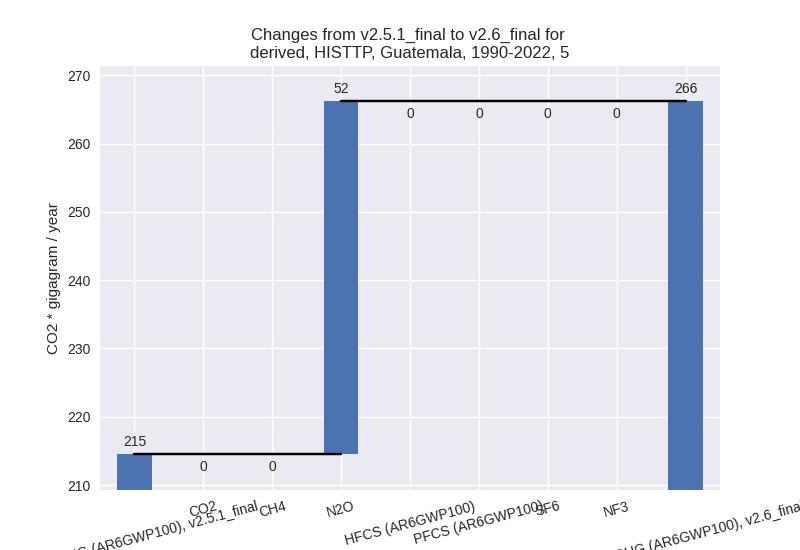Changes in PRIMAP-hist v2.6_final compared to v2.5.1_final for Guatemala
2024-09-24
Johannes Gütschow
Change analysis for Guatemala for PRIMAP-hist v2.6_final compared to v2.5.1_final
Overview over emissions by sector and gas
The following figures show the aggregate national total emissions excluding LULUCF AR6GWP100 for the country reported priority scenario. The dotted linesshow the v2.5.1_final data.
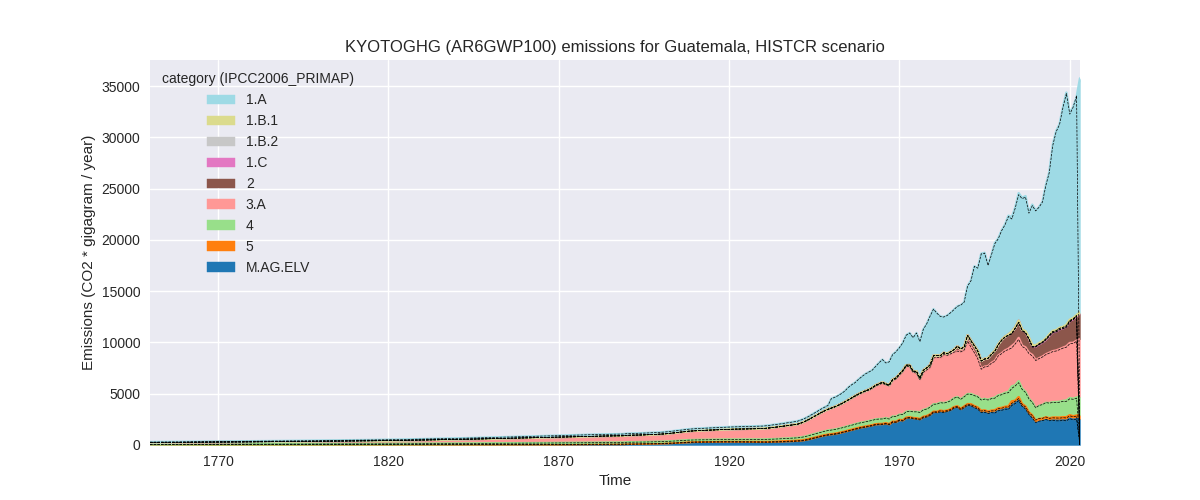
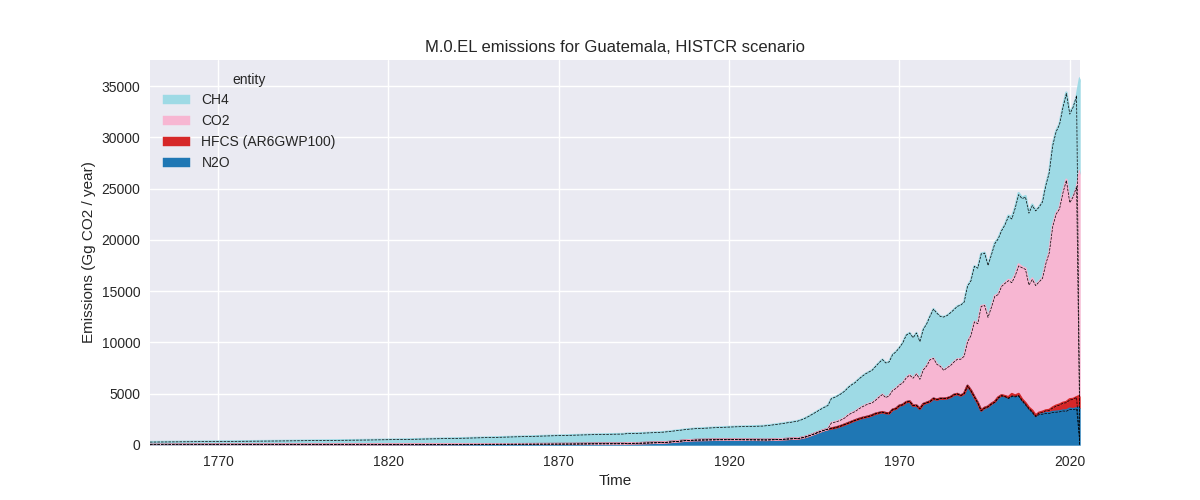
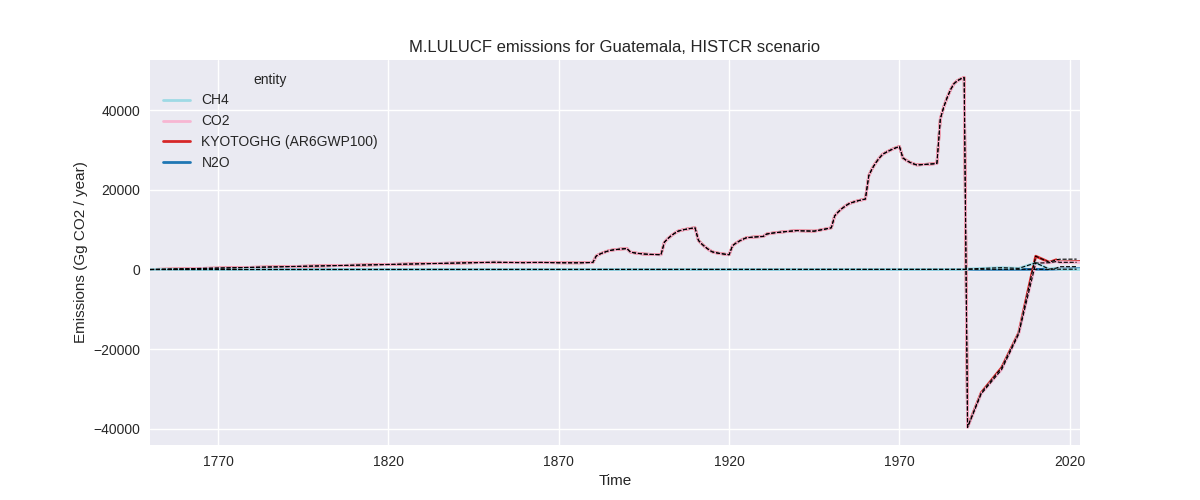
The following figures show the aggregate national total emissions excluding LULUCF AR6GWP100 for the third party priority scenario. The dotted linesshow the v2.5.1_final data.
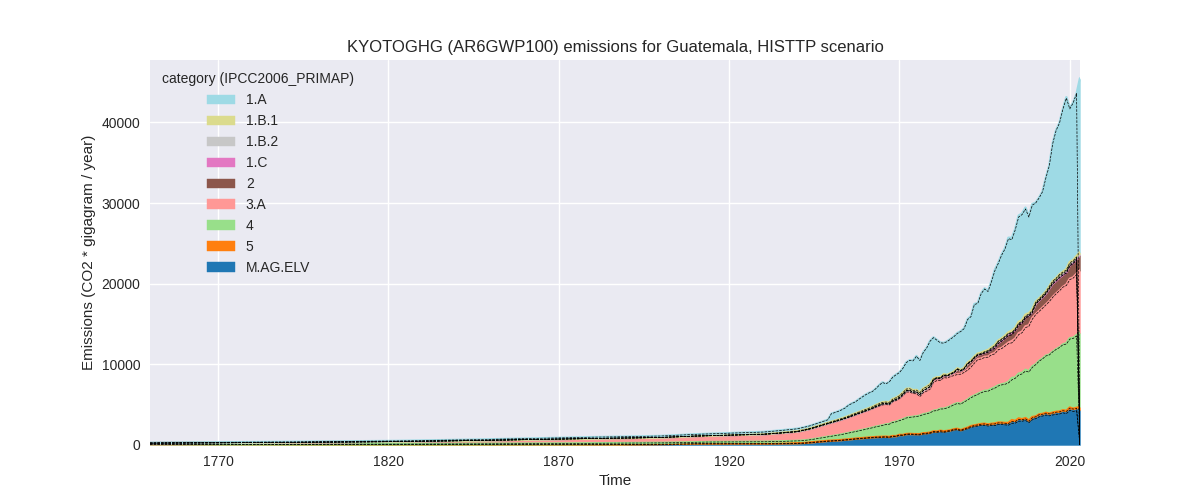

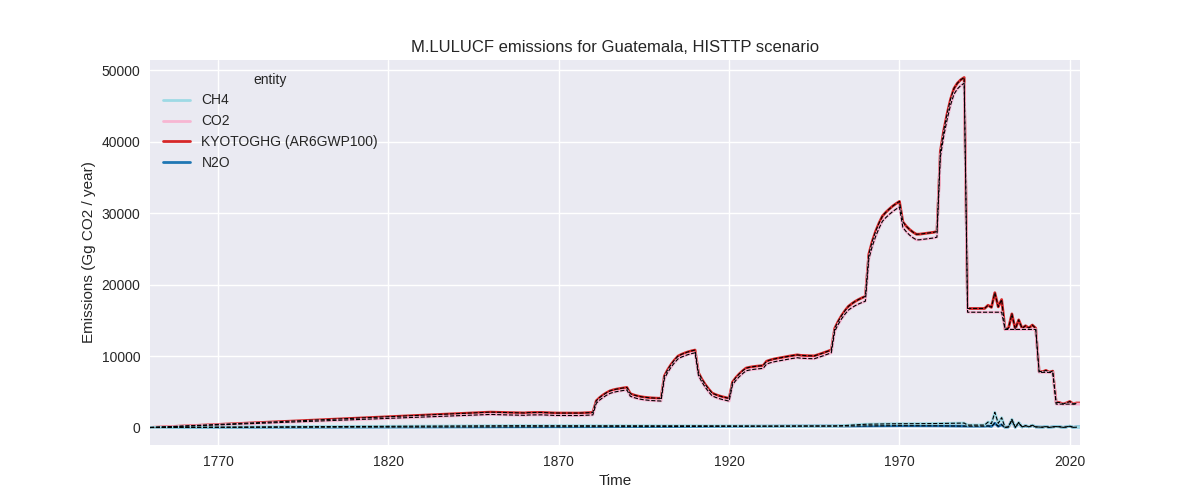
Overview over changes
In the country reported priority scenario we have the following changes for aggregate Kyoto GHG and national total emissions excluding LULUCF (M.0.EL):
- Emissions in 2022 have changed by -0.4%% (-148.31 Gg CO2 / year)
- Emissions in 1990-2022 have changed by 0.2%% (43.33 Gg CO2 / year)
In the third party priority scenario we have the following changes for aggregate Kyoto GHG and national total emissions excluding LULUCF (M.0.EL):
- Emissions in 2022 have changed by -0.1%% (-65.28 Gg CO2 / year)
- Emissions in 1990-2022 have changed by 0.3%% (75.27 Gg CO2 / year)
Most important changes per scenario and time frame
In the country reported priority scenario the following sector-gas combinations have the highest absolute impact on national total KyotoGHG (AR6GWP100) emissions in 2022 (top 5):
- 1: 1.A, CO2 with -172.36 Gg CO2 / year (-0.9%)
- 2: 5, N2O with 50.88 Gg CO2 / year (16.7%)
- 3: 2, HFCS (AR6GWP100) with -36.91 Gg CO2 / year (-3.3%)
- 4: 4, CH4 with 11.36 Gg CO2 / year (0.8%)
- 5: 4, N2O with -1.28 Gg CO2 / year (-0.5%)
In the country reported priority scenario the following sector-gas combinations have the highest absolute impact on national total KyotoGHG (AR6GWP100) emissions in 1990-2022 (top 5):
- 1: 5, N2O with 51.66 Gg CO2 / year (24.1%)
- 2: M.AG.ELV, CH4 with -12.23 Gg CO2 / year (-5.7%)
- 3: 3.A, CH4 with 12.09 Gg CO2 / year (0.3%)
- 4: 1.A, CH4 with -9.07 Gg CO2 / year (-0.7%)
- 5: 1.B.2, CH4 with 8.59 Gg CO2 / year (20.3%)
In the third party priority scenario the following sector-gas combinations have the highest absolute impact on national total KyotoGHG (AR6GWP100) emissions in 2022 (top 5):
- 1: 1.A, CO2 with -153.63 Gg CO2 / year (-0.9%)
- 2: 5, N2O with 50.88 Gg CO2 / year (16.7%)
- 3: 4, CH4 with 26.90 Gg CO2 / year (0.3%)
- 4: 4, N2O with 5.63 Gg CO2 / year (2.5%)
- 5: 2, HFCS (AR6GWP100) with 4.95 Gg CO2 / year (1.5%)
In the third party priority scenario the following sector-gas combinations have the highest absolute impact on national total KyotoGHG (AR6GWP100) emissions in 1990-2022 (top 5):
- 1: 5, N2O with 51.66 Gg CO2 / year (24.1%)
- 2: 4, CH4 with 27.07 Gg CO2 / year (0.5%)
- 3: 1.A, CO2 with -6.52 Gg CO2 / year (-0.1%)
- 4: 4, N2O with 2.91 Gg CO2 / year (2.0%)
- 5: 2, HFCS (AR6GWP100) with 0.15 Gg CO2 / year (0.1%)
Notes on data changes
Here we list notes explaining important emissions changes for the country. ’' means that the following text only applies to the TP time series, while means that it only applies to the CR scenario. Otherwise the note applies to both scenarios.
- Smaller changes are from adjustments in the downscaling configuration and the change in the trend period for numerical extrapolation.
Changes by sector and gas
For each scenario and time frame the changes are displayed for all individual sectors and all individual gases. In the sector plot we use aggregate Kyoto GHGs in AR6GWP100. In the gas plot we usenational total emissions without LULUCF. ## country reported scenario
2022
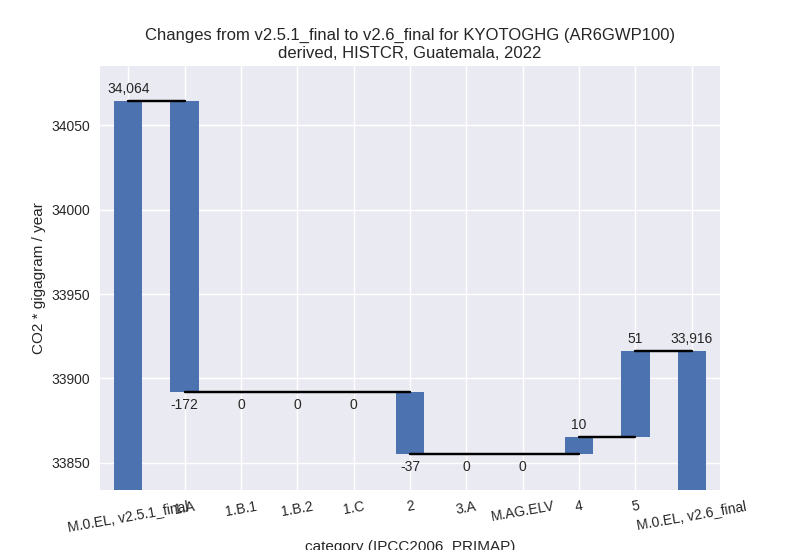
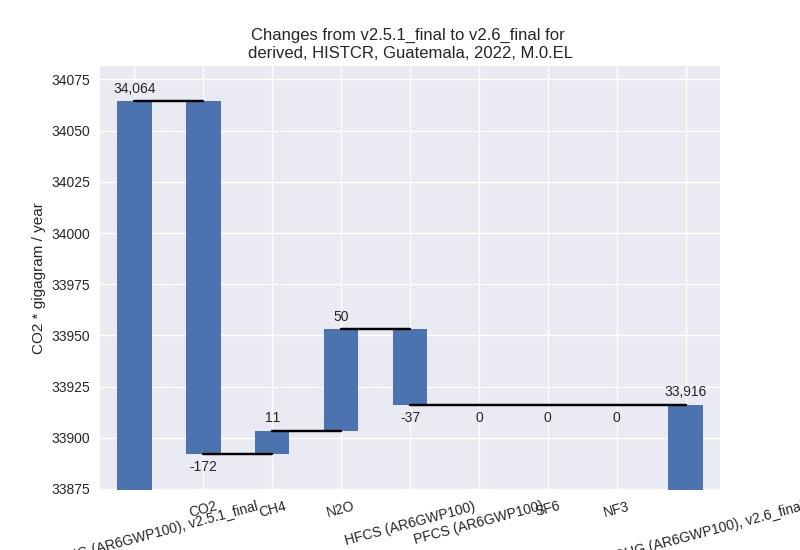
1990-2022
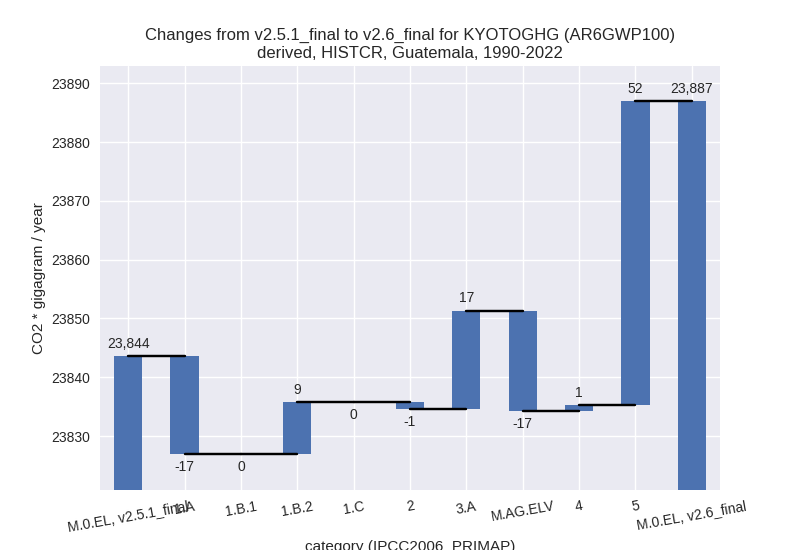
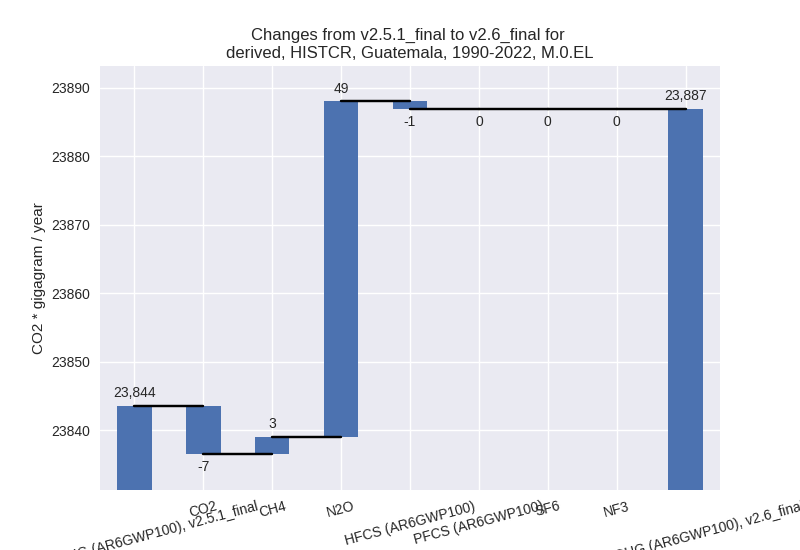
third party scenario
2022
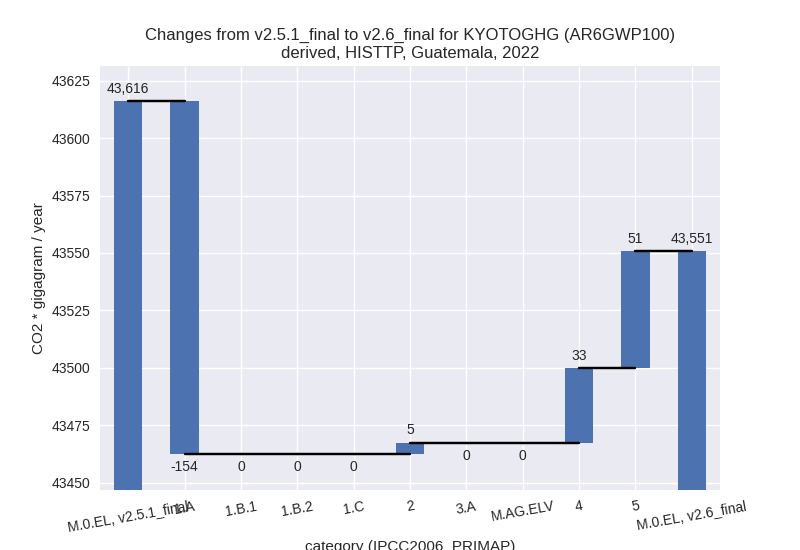
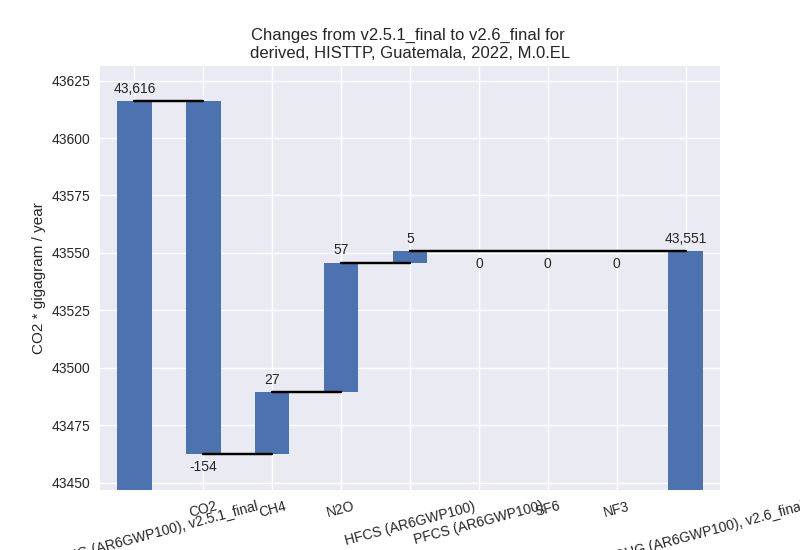
1990-2022
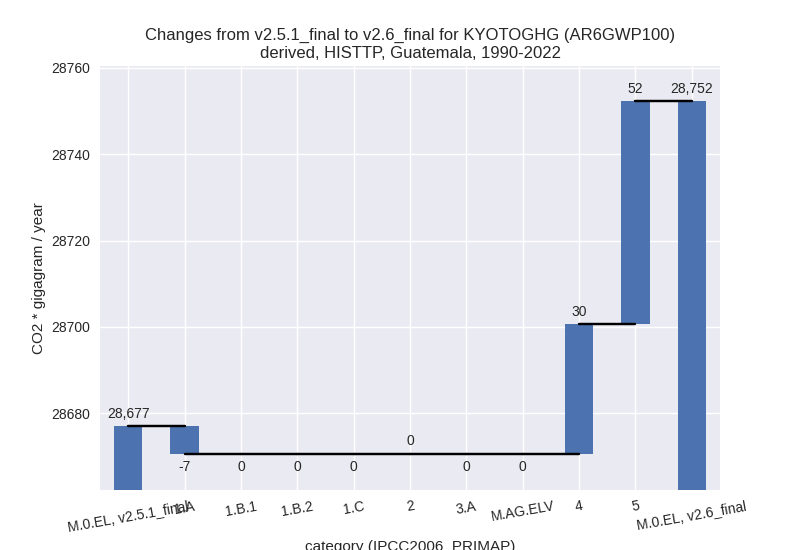
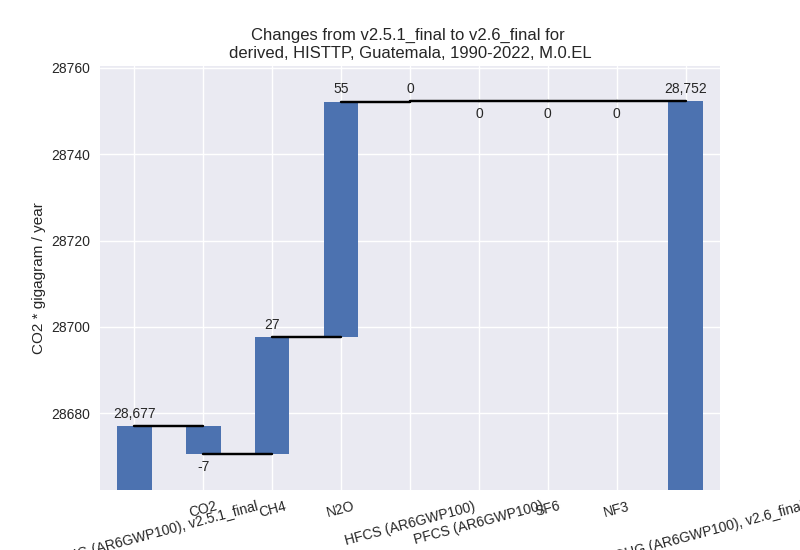
Detailed changes for the scenarios:
country reported scenario (HISTCR):
Most important changes per time frame
For 2022 the following sector-gas combinations have the highest absolute impact on national total KyotoGHG (AR6GWP100) emissions in 2022 (top 5):
- 1: 1.A, CO2 with -172.36 Gg CO2 / year (-0.9%)
- 2: 5, N2O with 50.88 Gg CO2 / year (16.7%)
- 3: 2, HFCS (AR6GWP100) with -36.91 Gg CO2 / year (-3.3%)
- 4: 4, CH4 with 11.36 Gg CO2 / year (0.8%)
- 5: 4, N2O with -1.28 Gg CO2 / year (-0.5%)
For 1990-2022 the following sector-gas combinations have the highest absolute impact on national total KyotoGHG (AR6GWP100) emissions in 1990-2022 (top 5):
- 1: 5, N2O with 51.66 Gg CO2 / year (24.1%)
- 2: M.AG.ELV, CH4 with -12.23 Gg CO2 / year (-5.7%)
- 3: 3.A, CH4 with 12.09 Gg CO2 / year (0.3%)
- 4: 1.A, CH4 with -9.07 Gg CO2 / year (-0.7%)
- 5: 1.B.2, CH4 with 8.59 Gg CO2 / year (20.3%)
Changes in the main sectors for aggregate KyotoGHG (AR6GWP100) are
- 1: Total sectoral emissions in 2022 are 21352.80 Gg CO2 / year which is 63.0% of M.0.EL emissions. 2022 Emissions have changed by -0.8% (-172.36 Gg CO2 / year). 1990-2022 Emissions have changed by -0.1% (-7.87 Gg CO2 / year).
- 2: Total sectoral emissions in 2022 are 2390.77 Gg CO2 / year which is 7.0% of M.0.EL emissions. 2022 Emissions have changed by -1.5% (-36.91 Gg CO2 / year). 1990-2022 Emissions have changed by -0.1% (-1.11 Gg CO2 / year).
- M.AG: Total sectoral emissions in 2022 are 8061.54 Gg CO2 / year which is 23.8% of M.0.EL emissions. 2022 Emissions have changed by 0.0% (0.00 Gg CO2 / year). 1990-2022 Emissions have changed by -0.0% (-0.34 Gg CO2 / year).
- 4: Total sectoral emissions in 2022 are 1754.76 Gg CO2 / year which is 5.2% of M.0.EL emissions. 2022 Emissions have changed by 0.6% (10.07 Gg CO2 / year). 1990-2022 Emissions have changed by 0.1% (1.00 Gg CO2 / year).
- 5: Total sectoral emissions in 2022 are 356.17 Gg
CO2 / year which is 1.1% of M.0.EL emissions. 2022 Emissions have
changed by 16.7% (50.88 Gg CO2 /
year). 1990-2022 Emissions have changed by 24.1% (51.66 Gg CO2 / year). For 2022 the
changes per gas
are:
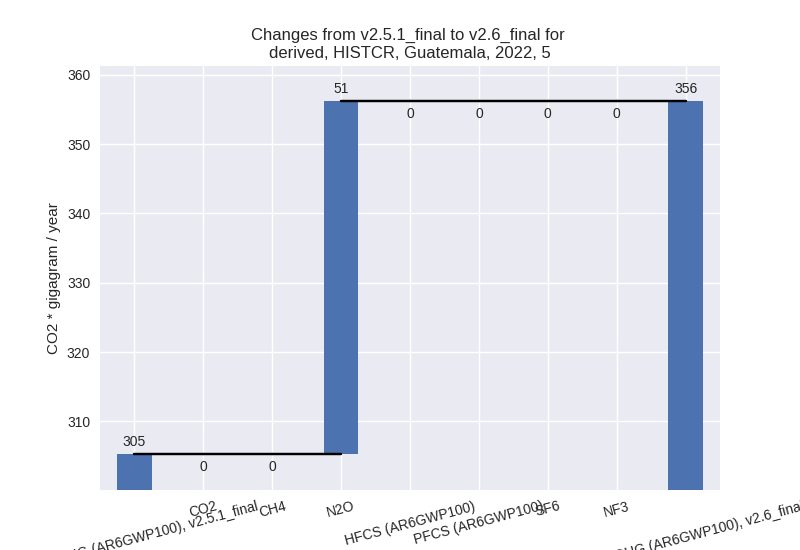
For 1990-2022 the changes per gas are: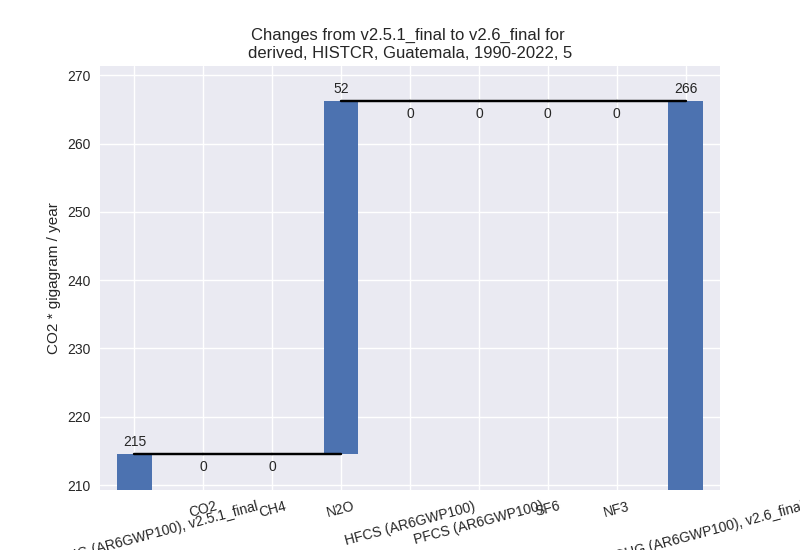
third party scenario (HISTTP):
Most important changes per time frame
For 2022 the following sector-gas combinations have the highest absolute impact on national total KyotoGHG (AR6GWP100) emissions in 2022 (top 5):
- 1: 1.A, CO2 with -153.63 Gg CO2 / year (-0.9%)
- 2: 5, N2O with 50.88 Gg CO2 / year (16.7%)
- 3: 4, CH4 with 26.90 Gg CO2 / year (0.3%)
- 4: 4, N2O with 5.63 Gg CO2 / year (2.5%)
- 5: 2, HFCS (AR6GWP100) with 4.95 Gg CO2 / year (1.5%)
For 1990-2022 the following sector-gas combinations have the highest absolute impact on national total KyotoGHG (AR6GWP100) emissions in 1990-2022 (top 5):
- 1: 5, N2O with 51.66 Gg CO2 / year (24.1%)
- 2: 4, CH4 with 27.07 Gg CO2 / year (0.5%)
- 3: 1.A, CO2 with -6.52 Gg CO2 / year (-0.1%)
- 4: 4, N2O with 2.91 Gg CO2 / year (2.0%)
- 5: 2, HFCS (AR6GWP100) with 0.15 Gg CO2 / year (0.1%)
Changes in the main sectors for aggregate KyotoGHG (AR6GWP100) are
- 1: Total sectoral emissions in 2022 are 20479.20 Gg CO2 / year which is 47.0% of M.0.EL emissions. 2022 Emissions have changed by -0.7% (-153.63 Gg CO2 / year). 1990-2022 Emissions have changed by -0.1% (-6.52 Gg CO2 / year).
- 2: Total sectoral emissions in 2022 are 1839.81 Gg CO2 / year which is 4.2% of M.0.EL emissions. 2022 Emissions have changed by 0.3% (4.95 Gg CO2 / year). 1990-2022 Emissions have changed by 0.0% (0.15 Gg CO2 / year).
- M.AG: Total sectoral emissions in 2022 are 11867.44 Gg CO2 / year which is 27.2% of M.0.EL emissions. 2022 Emissions have changed by 0.0% (0.00 Gg CO2 / year). 1990-2022 Emissions have changed by 0.0% (0.00 Gg CO2 / year).
- 4: Total sectoral emissions in 2022 are 9008.11 Gg CO2 / year which is 20.7% of M.0.EL emissions. 2022 Emissions have changed by 0.4% (32.51 Gg CO2 / year). 1990-2022 Emissions have changed by 0.5% (29.98 Gg CO2 / year).
- 5: Total sectoral emissions in 2022 are 356.17 Gg
CO2 / year which is 0.8% of M.0.EL emissions. 2022 Emissions have
changed by 16.7% (50.88 Gg CO2 /
year). 1990-2022 Emissions have changed by 24.1% (51.66 Gg CO2 / year). For 2022 the
changes per gas
are:
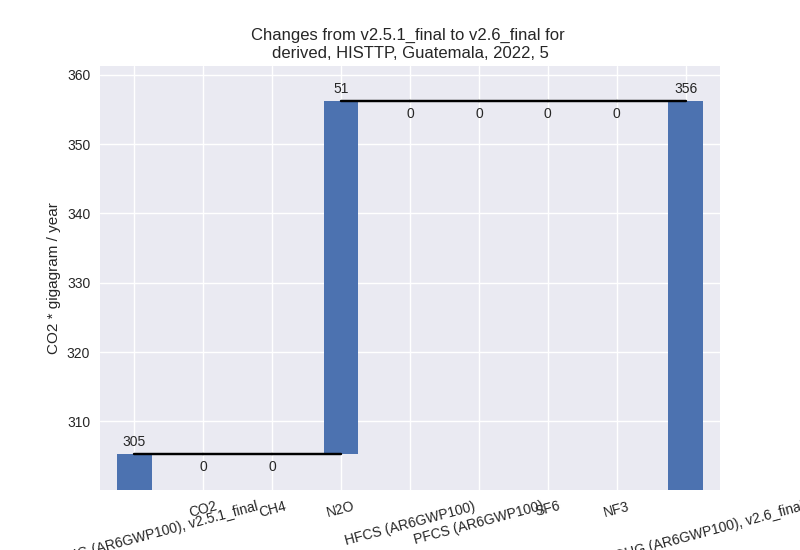
For 1990-2022 the changes per gas are: